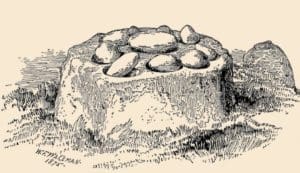The Alchemy of Alcohol: Uncovering the History of Ancient Libations

Updated On: April 23, 2024 by Maha Yassin
The alchemical process that turns grains, fruits, and honey into intoxicating liquids has been a part of human civilisation for thousands of years. As we trace the lineage of alcoholic beverages, we find that every culture has its iteration of alcohol, each with a distinct history, production method, and cultural significance. From the earliest known beer recipe attributed to the Sumerian goddess Ninkasi around 1800 BCE to the wine remnants found near the Euphrates and Tigris rivers dating circa 7,000 BC, these ancient drinks have evolved through history. They are an inseparable part of our social rituals and solitary moments of relaxation.
Continuing the journey through time, the alchemy of alcohol is evident in the way distilleries like Kilbeggan have weathered financial upheavals and shifts in consumer trends, mirroring the broader narrative of alcohol’s place in society. Likewise, historical techniques such as fermentation and distillation have transformed remarkably, shaping the vast array of spirits and brews that populate modern bars and shelves. Regardless of the period, the making and consumption of alcohol has always served as a mirror, reflecting the era’s technological prowess, social structures, and economic conditions.
The Dawn of Alcohol: Neolithic Innovations

Tracing the roots of alcohol back to the Neolithic era reveals the profound impact of early agricultural practices on the development of fermented drinks. Our ancestors’ experimentation with crops, such as barley and rice, laid the foundation for a tradition that would influence civilizations for millennia.
Agricultural Origins
In the Neolithic period, the shift from nomadic lifestyles to settled agriculture was pivotal in alcohol production. Communities began cultivating barley and rice, which served as staple foods and as the basis for early alcoholic beverages. In China, the residue found in pottery from the Neolithic village of Jiahu in Henan Province indicates that a mixed fermented drink made from rice, honey, and fruit such as hawthorn was produced as early as 7000 BC.
- Pottery: Essential for fermentation and storage
- Ingredients: Barley, rice, honey, and local fruits like hawthorn
- Innovation: Combining agriculture with fermentation
Ancient Techniques
Fermentation was a revolutionary process discovered in the Neolithic era. With the development of pottery, Neolithic people could create and store alcoholic beverages. They utilised natural yeasts to ferment grape wine and beer. The process would involve the breakdown of sugars in the presence of yeast to produce alcohol and carbon dioxide. This technique was an early form of biotechnology that fundamentally advanced our ancestors’ understanding of fermentation.
- Beer and wine: Primary forms of alcohol
- Yeast: Natural catalyst for fermentation
- Grapes and barley: Key ingredients for wine and beer, respectively
By observing these early practices, we appreciate how the art of brewing and winemaking has evolved. The Neolithic era’s innovations were critical in shaping the future of alcoholic beverages, eventually embraced by multiple civilisations as an integral component of culture and social life. Through these ancient foundations, we see the enduring legacy of alcohol in civilisation and agriculture across the globe.
Cultural Significance: Alcohol in Ancient Civilisations
Alcohol has been integral to human history, shaping ancient civilisations’ cultural practices and social norms. Here, we explore its role in religious rituals and diverse applications in society and medicine.
Rituals and Gods
In the ancient world, alcohol was more than just a beverage; it was a divine elixir. The Middle East is home to some of the earliest evidence of alcohol production, with the Sumerians venerating the goddess Ninkasi with hymns celebrating beer. In Ancient Egypt, alcohol, particularly beer, was a staple offering to the gods and a key component in both state and domestic rituals. For the Incas, chicha, a type of corn beer, was central to rituals and festivals and often consumed in vast quantities to commune with the deities.
Social and Medical Use
Beyond its religious context, alcohol was valued for its social and medicinal properties. In Sumeria, beer was a universal drink, even for children, reflecting its perceived nutritional value. Ancient Egyptian papyri depict alcohol as medicine, with preparations for various ailments. Mesopotamian archaeological finds also suggest that alcohol was a social lubricant and a form of currency. The ceremonial use of cacao wine in Mesoamerica further underscores the wide-reaching social significance of alcohol in the new world, even before the arrival of European influences.
Alchemy of Alcohol: The Science of Fermentation

Our exploration into the alchemy of alcohol reveals a profound transformation where simple ingredients such as water, sugars, and grains transmute into complex beverages through the science of fermentation. This ancient process is both an art and a science, yielding drinks cherished across cultures and epochs.
Chemical Breakthroughs
The essence of fermentation lies in the metabolic action of yeast, an organism that converts sugars primarily into alcohol and carbon dioxide. A chemical reaction occurs when yeast is introduced to a solution containing sugars, such as those from grape must or malted barley. This reaction not only produces ethanol (the alcohol in drinks) but also contributes to the distinctive flavours and characteristics of fermented beverages. Through chemical analysis, we’ve understood the delicate balance of conditions needed for optimal fermentation, including temperature, pH levels, and air, which is essential for the yeast’s respiration before fermentation. Germany has been particularly influential in brewing science, contributing significantly to our understanding of yeast behaviour.
Modern Brewing Methods
Advancements in brewing technology and methods have fine-tuned the fermentation process, allowing for sophisticated control over the final product. Modern breweries utilise precise equipment to monitor and adjust variables such as temperature and oxygen levels, ensuring consistency and quality in beer production. Innovations such as using pure yeast strains and sterile environments also aid in mitigating the risk of contamination. These modern methods are rooted in the rich heritage of brewing and enable us to create a diverse range of beers that reflect the meticulous application of scientific knowledge blended with traditional practices.
Distillation: The Birth of Spirits
In the tapestry of human innovation, spirits’ birth through distillation is a remarkable achievement. It’s a process that has refined the essence of what we drink, ushering in an era of purity and variety in the world of alcohol.
Early Distillation
Initially, distillation was intertwined with alchemy, aiming to transform and purify substances. The fundamental distillation technique involves heating a liquid until it vaporises and then condensing the vapours back into a liquid, capturing the essence of the original substance. The origins of this practice can be traced back to ancient civilisations, with the art of distillation thought to have significant roots in Egyptian culture.
As early as the first centuries AD, distillation equipment appears in historical records, demonstrating the procedure’s antiquity. Across the centuries, these techniques slowly evolved, forming the cornerstone of the distillation methods we utilise in producing spirits today.
Enhancing Purity and Variety
Our understanding of distillation has significantly progressed from those early days, with particular advancements during the Islamic Golden Age. The quality and purity of spirits saw immense improvements, helping to establish the foundations from which the likes of whiskey, brandy, and vodka emerged. By refining the distillation apparatus, these alchemists set the stage for the modern production of spirits, giving us the diverse range of hard liquor we have today.
Each spirit, whether it’s the peaty depths of a Scotch whisky or the subtle notes of a fine cognac, owes its existence to the intricate art of distillation. This process enhances the alcoholic content and character, unlocking the potential for an array of flavours that tantalise the palate and mark the quality of truly refined alcohol.
Regional Alcoholic Innovations

In exploring the remarkable diversity of alcoholic beverages, we encounter traditions deeply rooted in the regional flora and historical practices.
European Grape Wines
The art of wine-making in Europe is steeped in history, with Georgian wine as perhaps the pinnacle of this ancient craft. Dating back millennia, evidence points to the Middle East as a starting point, specifically Iran, where archaeologists unearthed residue from a 7,000-year-old winery at Hajji Firuz Tepe. European grape wine, however, has seen numerous transformations, particularly with the famed vines of Henan Province, China, demonstrating the silk route’s impact on viticulture.
Asian Rice Wines
Asian rice wines stand as a testament to the versatility of rice in China. These wines present various flavours unique to each locality using rice and sometimes hawthorn fruits. Henan Province, for instance, has contributed significantly to the variance in rice wine production, highlighting regional agricultural influences on alcoholic innovation.
New World Fermentations
In the Andes region of South America, native populations such as the Aztecs cultivated a distinct brewing tradition, creating rich corn beer from maize. This fermentation process marked a departure from Old World methods, representing an innovative use of the resources available in South America. The practices developed here continue to influence contemporary brewing techniques as a celebration of New World fruits and grains.
Our shared history with alcohol illuminates a journey across continents, climates, and cultures. Every bottle uncorked and every glass poured carries the weight of civilisation’s past—embodying humanity’s universal quest to harness nature’s bounty in the pursuit of enjoyment and camaraderie.
Brewing and Distillation in the Modern Age

As we explore the evolution of alcoholic beverages, it’s evident that modern techniques and movements significantly shape the production and variety of beer, wine, and spirits.
Industrial Production
Large-scale breweries and distilleries utilise advanced technology to ensure product consistency and quality in industrial production. The distillation process, crucial for producing spirits with a high alcohol content, has been refined over the years. Using materials ranging from grape to barley, facilities employ automated systems to control every aspect of production, from the mashed ingredients to the precise inclusion of hops.
Moreover, the importance of sanitisation and the ability to control fermentation temperatures has led to the high-quality beer and wine we find globally, especially in markets like the USA. The use of malted grains remains central to brewing, with large-scale operations in places like Milwaukee and Denver becoming household names.
Craft and Artisanal Movements
Conversely, the craft and artisanal movements champion the personal touch in alcohol production. Craft breweries typically emphasise unique flavours and traditional methods. This revival and reinterpretation of ancient recipes often use locally sourced ingredients, including speciality hops and malted barley, to create distinct beer profiles.
Artisanal distilleries similarly focus on the quality of the spirits rather than the quantity. Whether it’s handcrafted whiskey or meticulously fermented wine, these small-scale establishments are respected for their innovative approaches and dedication to crafting beverages that reflect the character of their local surroundings.
We observe that whether it’s through industrial production or craft movements, the present-day brewing and distillation fields blend time-honoured traditions with modern advances to satisfy a world with an insatiable thirst for diverse alcoholic drinks.
From Pottery to Glass: Storage and Containers

The materials used to store alcoholic beverages like ale, champagne, and beer have evolved significantly over time, impacting the quality and taste of these drinks.
Evolution of Storage
We have witnessed substantial changes in the materials used for storing drinks. Initially, our ancestors relied on pottery vessels, which were notable for their porous nature and sometimes allowed air to influence the brewing process. These stone mortars and ceramic and clay pots were crucial in the storage and fermentation processes, affecting the flavour profile of ancient beverages. Later advancements saw the introduction of glass containers, transforming storage with a non-reactive barrier that preserved the original taste and quality of the liquid inside.
Influence on Taste
The material of the container in which alcohol is stored plays a key role in shaping its final taste. Being slightly porous, pottery often allows minor chemical interactions between the stored liquid and the environment, which could alter the flavour. In contrast, glass is inert and offers a stable environment, ensuring that drinks like champagne retain their intended quality and flavour profile. It is especially necessary for storage over long periods, allowing beverages to mature without adverse external influences.
The Role of Ingredients in Alcohol Varieties

The intricate selection of ingredients is pivotal in crafting diverse alcohol varieties, each contributing unique characteristics to the final beverage.
Selecting The Right Grains
Grains are the backbone of many alcoholic drinks, providing the essential sugars for fermentation. Barley is favoured for its rich enzymes, creating the perfect base for beer and whisky. We also see rye and maize used extensively, adding a distinctive spicy note and a smooth sweetness. These grains are carefully chosen for the specific tastes they impart and the traditions they uphold.
Importance of Water Quality
Water, the lifeblood of alcohol production, not only constitutes the largest component of the final product but also impacts its taste profile. The purity and mineral content can vary widely, with some regions like Scotland’s clear springs adding a soft quality to their whiskies. We, as connoisseurs, recognise that the water source can make or break the quality of the drink.
Flavour from Fruits and Herbs
Fruits and herbs add the nuances that make each drink a unique art form. Grapes create a spectrum of wines, from crisp whites to robust reds. Fruits like apples and honey often find their way into ciders and meads. Meanwhile, hops are revered for their bittering properties and aromatic contribution to beer. We also use a range of herbs to elevate the flavour profiles, adding complexity to beverages like gin.
Archaeology and History: Unearthing Alcohol’s Past

In our quest to understand the origins of alcohol, we turn to archaeology and historical records, which have revealed much about the drinks of our ancestors.
Archaeological Discoveries
Archaeologists have unearthed evidence of early alcoholic beverages at multiple sites across the globe. One pivotal discovery occurred within the Zagros Mountains at a site called Godin Tepe. Here, they found residues indicative of beer production dating back to 3500–3100 BCE. This finding, published in the Proceedings of the National Academy of Sciences, points to one of the earliest known beer-making operations.
Further excavations in Georgia have uncovered pottery from around 6000 BCE containing remnants of grape wine, pushing back the date of the earliest known winemaking. These stone mortars and other relics provide insights into the techniques and materials our forebears utilised to create their alcoholic concoctions.
Examining Historical Records
Historical records complement our archaeological findings, particularly from ancient civilisations like the Shang dynasty in China and the ancient Sumerian society. These records include detailed notations of brewing and drinking rituals, showcasing the cultural significance of alcohol.
Documents and artefacts housed in institutions such as the Penn Museum offer a direct line to understanding the social and ceremonial roles that alcohol played. Through analysis of these ancient materials, we forge a deeper connection with the collective human experience, which has always included the fermentation and enjoyment of alcohol.
Social Impacts of Alcohol Consumption

The consumption of alcohol has shaped social interactions and public health for centuries. From festive toasts to societal challenges, its influence is undeniable.
Traditional Celebrations
Alcohol has long played a significant role in traditional celebrations and cultural rituals across civilisations. Wine is often featured in Christian rituals, symbolising the blood of Christ, while in ancient Greek culture, Aristotle and his peers regularly engaged in symposia, where wine facilitated philosophical discussions. Many recipes for traditional alcoholic beverages are passed down through generations, becoming part of the cultural heritage. For instance, spirits like whiskey have been entwined with local customs and celebrations for centuries in Ireland.
Alcohol and Public Health
The impact of alcohol on public health is a complex issue, covering a spectrum of consequences. Excessive alcohol consumption has been linked to various health problems, from acute injuries caused by accidents to long-term diseases like liver cirrhosis. Public health campaigns often highlight these risks, encouraging moderation. It’s essential to strike a balance, recognising the enjoyment wine and beer bring to many while also addressing the potential for misuse and its attendant health implications.
The Future of Alcoholic Beverages

As we explore the world’s oldest drinks, the future of alcoholic beverages is shaped by innovative production methods and changing global consumption patterns.
Innovation in Production
The art of creating alcoholic beverages has always been a testament to human ingenuity, but future fermentation techniques and distillation processes promise to revolutionise the industry further. Pioneering breweries and distillers are leveraging novel yeasts and advanced scientific approaches to enhance the quality and diversity of spirits and fermented beverages. This wave of innovation isn’t just about taste—it’s also about sustainability, with many producers focusing on eco-friendlier practices to minimise their environmental footprint.
Global Trends and Consumption
Globally, trends indicate a shift towards low- and no-alcohol alternatives, aligning with a growing health consciousness among consumers. In stark contrast, the demand for premium and craft spirits continues to rise, suggesting a duality in consumption where quality often trumps quantity. Moreover, with increasing global connectivity, there’s a heightened interest in exotic and culturally significant beverages, leading us to embrace the global diversity of alcoholic creations. Our consumption reflects our preferences and values, driving the industry towards more thoughtful practices that respect the rich tapestry of humanity.
These insights only skim the surface of the future, yet they offer a snapshot of the dynamic landscape of alcoholic beverages as we progress.
FAQs
This section addresses some of the most common queries about the world’s oldest alcoholic drinks, ranging from their historical origins to their impact on early medicinal practices.
Which is the earliest known alcoholic beverage in human history?
The earliest known alcoholic beverage in human history is believed to be a form of beer dating back to around 10,000 years ago, with evidence discovered at the site of Göbekli Tepe in Turkey.
What were the origins of wine, and is it considered the oldest of alcoholic drinks?
While wine is not the most ancient, it has a long history with evidence of wine production from around 7,000 BC in the region near the Euphrates and Tigris rivers, which was part of the cultural practices of early civilisations there.
Can you outline a brief timeline detailing the history of alcoholic beverages?
A brief timeline of alcoholic beverages: beer-like drinks in Turkey around 10,000 BC, wine by 7,000 BC in the Middle East, distillation possibly in ancient Greece, with significant development in medieval times, and then the establishment of formal distilleries, such as The Glenturret Distillery in Scotland in 1763.
How have the oldest forms of alcohol been priced historically and in contemporary times?
Historically, the oldest forms of alcohol were sometimes seen as currency or symbols of status and wealth. In contemporary times, ancient alcohol recipes can be highly prized, with rare bottles of whisky and wine fetching substantial sums at auctions.
What role did alcohol play in the development of early medicine?
Alcohol was integral to early medicine, used as an antiseptic to clean wounds and for its perceived curative properties; it was a common component in many medicinal concoctions and elixirs.
In what ways did early civilisations utilise distillation methods to produce alcohol?
Early civilisations utilised basic distillation methods to produce alcohol and create stronger and purer spirits. This practice evolved over time and became more sophisticated, leading to the variety of distilled alcoholic beverages available today.






